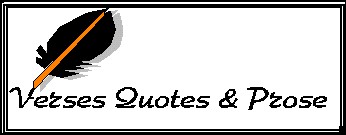

Contents
1.
Favourite quotes & verses 2.
Traditional pantun 3.
Haiku![]() __________________________________________
1.
Favourite quotes & verses
__________________________________________
1.
Favourite quotes & verses
The practice of including verse and rhyme is never better understood than by the Chinese artists in Chinese art, where the calligraphy completes the paintings. Verse and rhyme have a way of enhancing any artwork as they add intensity and an enhanced mood to any artwork. Similarly such common and uncommon verse and rhyme may be made a part of any greeting card or note card so as to add interest and a personal touch to the card or notepaper. Try it.
For now, the quotes and verses are presented under the following headings:
(Click on subject)
|
|
Beauty | Birthday | Friendship | Happines | Inspirational | Love | Marriage | Money | Philosophy |
| Solitude |
|
|
|
X'mas |
...
 Marriage
Marriage Bahasa
& Budaya
Bahasa
& Budaya
 -Pantun
-Pantun
We intend to expand the section on contemporary pantuns and welcome contributions from anyone who would like to have his/her pantun included in the compilation. Please email to : hsh17@singnet.com.sg (case sensitive), We also welcome any original sketches and artwork which viewers may wish to contribute to illustrate the pantuns.
_____________________________________________________________________________________
 Haiku
is a traditional Japanese verse form which has gained international following.
This literary genre is characterised by the zen philosophy inherent in
the verseform. Haiku demonstrates both in form and in spirit the impact
and essence of simple expression. In Haiku the objective is a sharing of
experiences; it is an involvment in imagery, colours, and emotions - a
literary zen art or a creative doodle if you like, depending on the stage
of development of the writer. Haiku has been taught to very young school
children from the United States to Singapore, but the art of the Haiku
is a serious literary skill.
Haiku
is a traditional Japanese verse form which has gained international following.
This literary genre is characterised by the zen philosophy inherent in
the verseform. Haiku demonstrates both in form and in spirit the impact
and essence of simple expression. In Haiku the objective is a sharing of
experiences; it is an involvment in imagery, colours, and emotions - a
literary zen art or a creative doodle if you like, depending on the stage
of development of the writer. Haiku has been taught to very young school
children from the United States to Singapore, but the art of the Haiku
is a serious literary skill.
Briefly described, this Japanese verse form is a three line verse which is not quite concerned in rhymes. Logistically, Haiku is said to be written in the 5/7/5-beat structure. There is however some controversy when Haiku is written in English as some writers believe it should be written to a 2/3/2-beat structure. Contemporary literary works adopting the haiku form have taken this verse form to new horizons.
These two passages by William J Higginson with Penny Harter from The Haiku Handbook best describe what a Haiku is supposed to be and to do:
Some examples of the traditional and contemporary Haikus are reproduced below.
 in
the flower-field
are rocks, are hollows,
and are flowers
(Yamaguchi Seishi) (in
Japanese)
in
the flower-field
are rocks, are hollows,
and are flowers
(Yamaguchi Seishi) (in
Japanese)
 chrysanthemums
chrysanthemums
 Under
moon shadows
A tall boy flashes knife and
Slices star bright ice
(Etherfidge Knight)
Under
moon shadows
A tall boy flashes knife and
Slices star bright ice
(Etherfidge Knight)
 almost breathless...almost
almost there
(SH Hardjoe)
almost breathless...almost
almost there
(SH Hardjoe)
 furry
rascal
furry
rascal


 my
love . . .
my
love . . .
 (Hairani
Saban)
I remember
you remembered
one yellow rose
(Hairani
Saban)
I remember
you remembered
one yellow rose
___________________________________________________________________________________